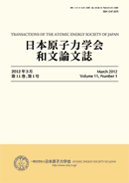Volume 18, Issue 4
Displaying 1-6 of 6 articles from this issue
- |<
- <
- 1
- >
- >|
Article
-
2019Volume 18Issue 4 Pages 199-209
Published: 2019
Released on J-STAGE: November 20, 2019
Advance online publication: October 25, 2019Download PDF (1404K) -
2019Volume 18Issue 4 Pages 210-218
Published: 2019
Released on J-STAGE: November 20, 2019
Advance online publication: October 25, 2019Download PDF (2712K) -
2019Volume 18Issue 4 Pages 219-225
Published: 2019
Released on J-STAGE: November 20, 2019
Advance online publication: October 25, 2019Download PDF (4682K) -
2019Volume 18Issue 4 Pages 226-236
Published: 2019
Released on J-STAGE: November 20, 2019
Advance online publication: October 25, 2019Download PDF (3713K)
Technical Material
-
2019Volume 18Issue 4 Pages 237-245
Published: 2019
Released on J-STAGE: November 20, 2019
Advance online publication: October 25, 2019Download PDF (1675K)
Corrigendum
-
2019Volume 18Issue 4 Pages 246
Published: 2019
Released on J-STAGE: November 20, 2019
Download PDF (517K)
- |<
- <
- 1
- >
- >|
